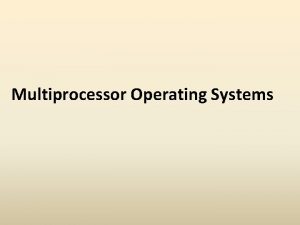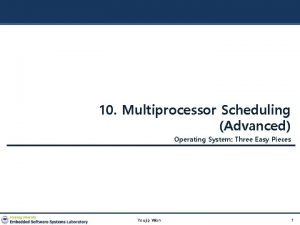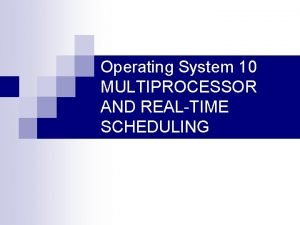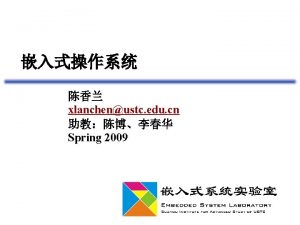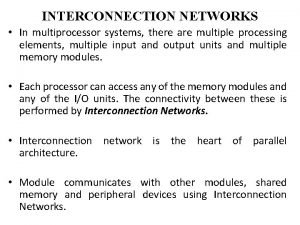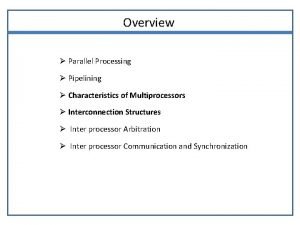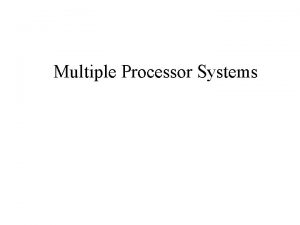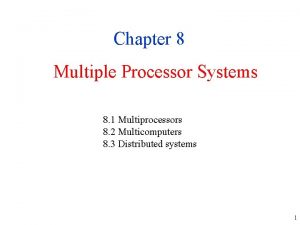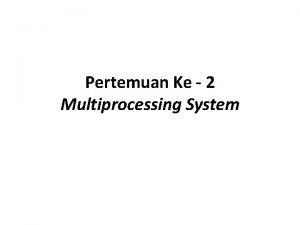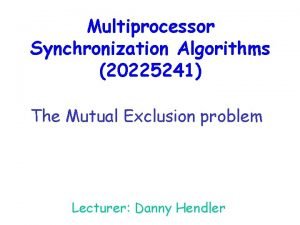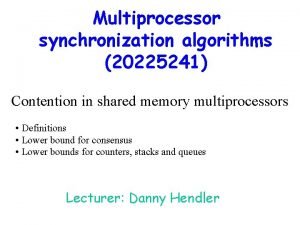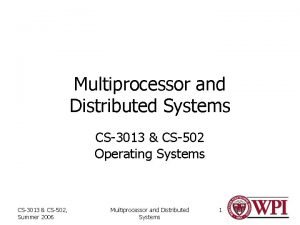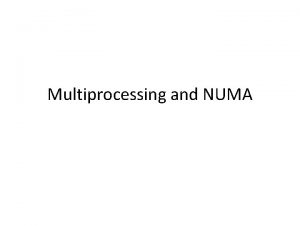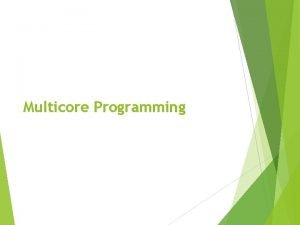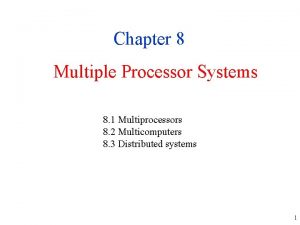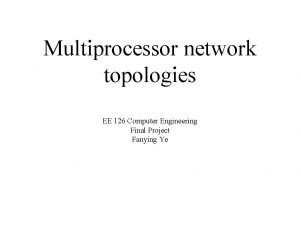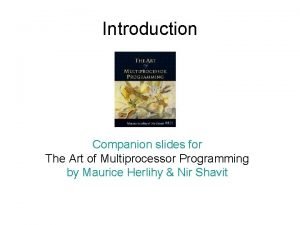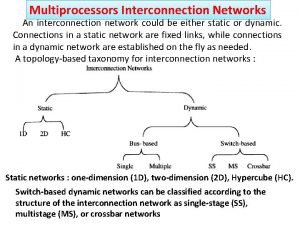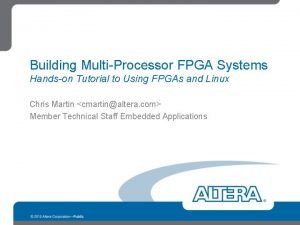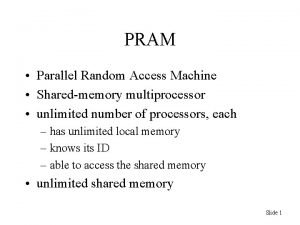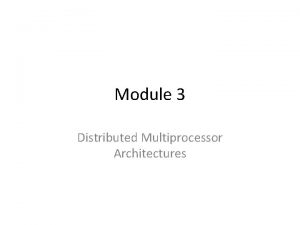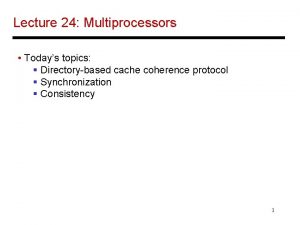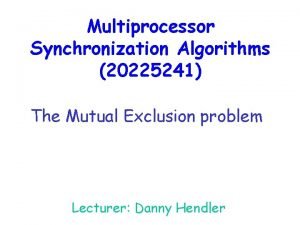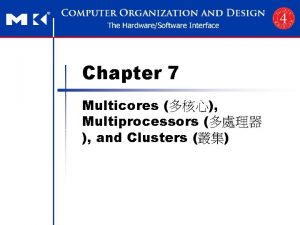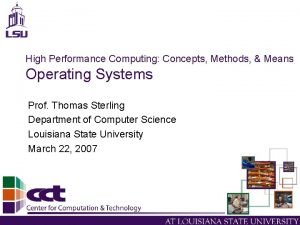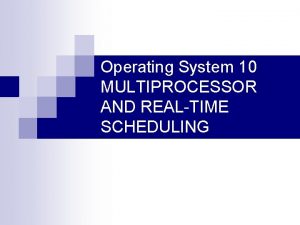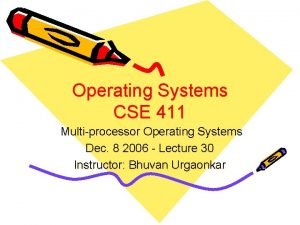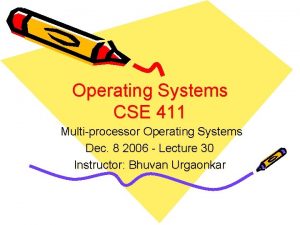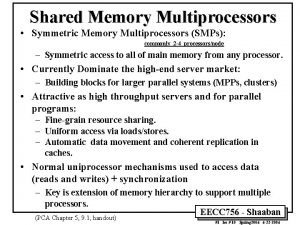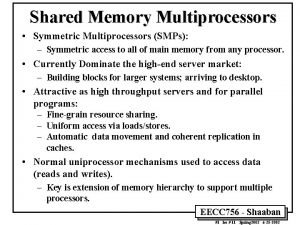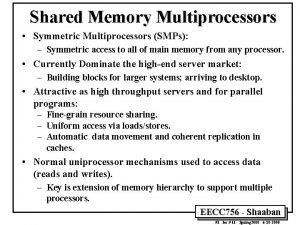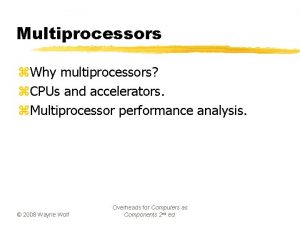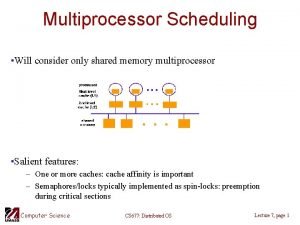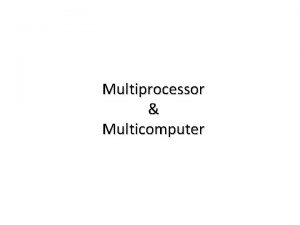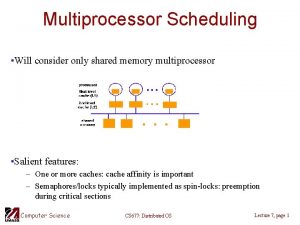Multiprocessor Operating Systems Motivation for Multiprocessors Enhanced Performance






























- Slides: 30

Multiprocessor Operating Systems

Motivation for Multiprocessors • Enhanced Performance – Concurrent execution of tasks for increased throughput (between processes) – Exploit Concurrency in Tasks (Parallelism within process) • Fault Tolerance – graceful degradation in face of failures

Basic MP Architectures • Single Instruction Single Data (SISD) conventional uniprocessor designs. • Single Instruction Multiple Data (SIMD) Vector and Array Processors • Multiple Instruction Single Data (MISD) Not Implemented. • Multiple Instruction Multiple Data (MIMD) conventional MP designs

MIMD Classifications • Tightly Coupled System - all processors share the same global memory and have the same address spaces (Typical SMP system). – Main memory for IPC and Synchronization. • Loosely Coupled System - memory is partitioned and attached to each processor. Hypercube, Clusters (Multi-Computer). – Message passing for IPC and synchronization.

MP Block Diagram CPU CPU cache MMU Interconnection Network MM MM

Memory Access Schemes • Uniform Memory Access (UMA) – Centrally located – All processors are equidistant (access times) • Non. Uniform Access (NUMA) – physically partitioned but accessible by all – processors have the same address space • NO Remote Memory Access (NORMA) – physically partitioned, not accessible by all – processors have own address space

Other Details of MP • Interconnection technology – Bus – Cross-Bar switch – Multistage Interconnect Network • Caching - Cache Coherence Problem! – Write-update – Write-invalidate – bus snooping

MP OS Structure - 1 • Separate Supervisor – all processors have their own copy of the kernel. – Some share data for interaction – dedicated I/O devices and file systems – good fault tolerance – bad for concurrency

MP OS Structure - 2 • Master/Slave Configuration – master monitors the status and assigns work to other processors (slaves) – Slaves are a schedulable pool of resources for the master – master can be bottleneck – poor fault tolerance

MP OS Structure - 3 • Symmetric Configuration - Most Flexible. – all processors are autonomous, treated equal – one copy of the kernel executed concurrently across all processors – Synchronize access to shared data structures: • Lock entire OS - Floating Master • Mitigated by dividing OS into segments that normally have little interaction • multithread kernel and control access to resources (continuum)

MP Overview Multi. Processor SIMD MIMD Shared Memory (tightly coupled) Master/Slave Symmetric (SMP) Distributed Memory (loosely coupled) Clusters

SMP OS Design Issues • Threads - effectiveness of parallelism depends on performance of primitives used to express and control concurrency. • Process Synchronization - disabling interrupts is not sufficient. • Process Scheduling - efficient, policy controlled, task scheduling (process/threads) – global versus per CPU scheduling – Task affinity for a particular CPU – resource accounting and intra-task thread dependencies

SMP OS design issues - 2 • Memory Management - complicated since main memory is shared by possibly many processors. Each processor must maintain its own map tables for each process – cache coherence – memory access synchronization – balancing overhead with increased concurrency • Reliability and fault Tolerance - degrade gracefully in the event of failures

Typical SMP System 500 MHz CPU CPU cache MMU Issues: • Memory contention • Limited bus BW • I/O contention • Cache coherence System/Memory Bus INT Main Memory 50 ns System Functions (timer, BIOS, reset) Bridge I/O subsystem ether scsi video

Some Definitions • Parallelism: degree to which a multiprocessor application achieves parallel execution • Concurrency: Maximum parallelism an application can achieve with unlimited processors • System Concurrency: kernel recognizes multiple threads of control in a program • User Concurrency: User space threads (coroutines) provide a natural programming model for concurrent applications. Concurrency not supported by system.

Process and Threads • Process: encompasses – set of threads (computational entities) – collection of resources • Thread: Dynamic object representing an execution path and computational state. – threads have their own computational state: PC, stack, user registers and private data – Remaining resources are shared amongst threads in a process

Threads • Effectiveness of parallel computing depends on the performance of the primitives used to express and control parallelism • Threads separate the notion of execution from the Process abstraction • Useful for expressing the intrinsic concurrency of a program regardless of resulting performance • Three types: User threads, kernel threads and Light Weight Processes (LWP)

User Level Threads • User level threads - supported by user level (thread) library – Benefits: • no modifications required to kernel • flexible and low cost – Drawbacks: • can not block without blocking entire process • no parallelism (not recognized by kernel)

Kernel Level Threads • Kernel level threads - kernel directly supports multiple threads of control in a process. Thread is the basic scheduling entity – Benefits: • coordination between scheduling and synchronization • less overhead than a process • suitable for parallel application – Drawbacks: • more expensive than user-level threads • generality leads to greater overhead

Light Weight Processes (LWP) • Kernel supported user thread • Each LWP is bound to one kernel thread. – a kernel thread may not be bound to an LWP • LWP is scheduled by kernel • User threads scheduled by library onto LWPs • Multiple LWPs per process

First Class threads (Psyche OS) • Thread operations in user space: – create, destroy, synch, context switch • kernel threads implement a virtual processor • Course grain in kernel - preemptive scheduling • Communication between kernel and threads library – shared data structures. – Software interrupts (user upcalls or signals). Example, for scheduling decisions and preemption warnings. – Kernel scheduler interface - allows dissimilar thread packages to coordinate.

Scheduler Activations • An activation: – serves as execution context for running thread – notifies thread of kernel events (upcall) – space for kernel to save processor context of current user thread when stopped by kernel • kernel is responsible for processor allocation => preemption by kernel. • Thread package responsible for scheduling threads on available processors (activations)

• BSD: Support for Threading – process model only. 4. 4 BSD enhancements. • Solaris: provides – user threads, kernel threads and LWPs • Mach: supports – kernel threads and tasks. Thread libraries provide semantics of user threads, LWPs and kernel threads. • Digital UNIX: extends MACH to provide usual UNIX semantics. – Pthreads library.

Mach • Two abstractions: – Task - static object, address space and system resources called port rights. – Thread - fundamental execution unit and runs in context of a task. • • Zero or more threads per task, kernel schedulable kernel stack computational state • Processor sets - available processors divided into nonintersecting sets. – permits dedicating processor sets to one or more tasks

Mach c-thread Implementations • Coroutine-based - multiples user threads onto a single-threaded task • Thread-based - one-to-one mapping from cthreads to Mach threads. Default. • Task-based - One Mach Task per c-thread.

Digital UNIX • Based on Mach 2. 5 kernel • Provides complete UNIX programmers interface • 4. 3 BSD code and ULTRIX code ported to Mach – u-area replaced by utask and uthread – proc structure retained

Digital UNIX threads • Signals divided into synchronous and asynchronous • global signal mask • each thread can define its own handlers for synchronous signals • global handlers for asynchronous signals

Pthreads library • One Mach thread per pthread • implements asynchronous I/O – separate thread created for synchronous I/O which in turn signals original thread • library includes signal handling, scheduling functions, and synchronization primitives.

Mach Continuations • Address problem of excessive kernel stack memory requirements • process model versus interrupt model – one per process kernel stack versus a per thread kernel stack • Thread is first responsible for saving any required state (the thread structure allows up to 28 bytes) • indicate a function to be invoked when unblocked (the continuation function) • Advantage: stack can be transferred between threads eliminating copy overhead.

• Thank You 30
 Multiprocessor operating system
Multiprocessor operating system Advanced operating system
Advanced operating system Dynamic multiprocessor systems.
Dynamic multiprocessor systems. Real-time executive for multiprocessor systems
Real-time executive for multiprocessor systems Interconnection networks in multiprocessor systems
Interconnection networks in multiprocessor systems Characteristics of multiprocessors
Characteristics of multiprocessors Interconnection structure of multiprocessor
Interconnection structure of multiprocessor Uma multiprocessors using multistage switching networks
Uma multiprocessors using multistage switching networks Multiple processor systems
Multiple processor systems Contoh multiprocessing
Contoh multiprocessing Multiprocessor synchronization
Multiprocessor synchronization Multiprocessor access contention
Multiprocessor access contention Tightly coupled multiprocessor
Tightly coupled multiprocessor Multiprocessor vs multicore
Multiprocessor vs multicore Multicore programming
Multicore programming Multiprocessor and multicomputer
Multiprocessor and multicomputer The art of multiprocessor programming exercise solutions
The art of multiprocessor programming exercise solutions Ee 126
Ee 126 Art of multiprocessor programming slides
Art of multiprocessor programming slides Dynamic interconnection network in computer architecture
Dynamic interconnection network in computer architecture Time shared common bus
Time shared common bus Multicore vs multiprocessor
Multicore vs multiprocessor In system memory content editor
In system memory content editor Crew pram
Crew pram Kmap
Kmap Multiprocessor
Multiprocessor Lamport bakery algorithm in distributed system
Lamport bakery algorithm in distributed system Arithmetic intensity
Arithmetic intensity Performance = motivation x ability
Performance = motivation x ability Performance = motivation x ability
Performance = motivation x ability High performance operating system
High performance operating system
